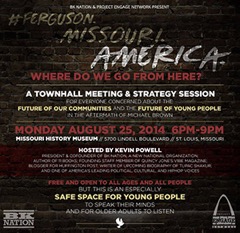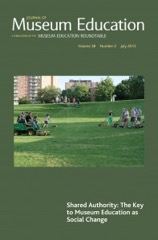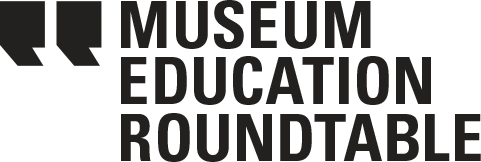Diversity and Slow Change
Museum Education Roundtable (MER) was out in force at the 2015 AAM Annual Meeting last week in Atlanta. Board members, including me, enjoyed connecting with members new and old at our joint reception with EdCom at the Museum of Contemporary Art of Georgia, the EdCom Marketplace of Ideas, and our newest tradition—MER Happy Hour.
The theme of this year’s AAM annual meeting was The Social Value of Museums: Inspiring Change, a topic of central importance to our field—an importance underscored by the events unfolding in Baltimore, MD as we gathered together to tackle the issue. On Monday morning keynote speaker Dr. Johnnetta Betsch Cole, Director of the Smithsonian National Museum of African Art, was critical of our field’s progress in fully representing the “beauty and strength” of our diverse nation. She stressed that this was not simply a failure to expand the range of stories we tell through our exhibits and collections, but a failure to build a museum workforce representative of the diverse communities we want to serve (a topic tackled in depth at the #MuseumWorkersSpeak rogue session of Tuesday evening). Dr. Cole concluded her inspiring and humbling talk with a simple but forceful call to action. Change is in OUR hands.
 By Monday night Baltimore was burning. Many in attendance at AAM were distraught by these events and seeking ways to answer Dr. Cole’s call to action. Luckily, Melanie Adams, Managing Director for Community Education and Events at the Missouri History Museum (MHM), was scheduled to present the next morning on her museum’s work in the wake of the shooting of Michael Brown in Ferguson, MO and the social unrest that followed. Adams provided some very valuable insight into the key ingredient for successful social engagement in museums—true community collaboration through mutually beneficial partnerships nurtured over many years. According to Adams, connecting and collaborating with organizations throughout the St. Louis area has been an institutional priority at MHM for 20 years. Today they have 75-100 community partners who they can turn to—and who can turn to MHM—to tackle social issues head-on in real time.
By Monday night Baltimore was burning. Many in attendance at AAM were distraught by these events and seeking ways to answer Dr. Cole’s call to action. Luckily, Melanie Adams, Managing Director for Community Education and Events at the Missouri History Museum (MHM), was scheduled to present the next morning on her museum’s work in the wake of the shooting of Michael Brown in Ferguson, MO and the social unrest that followed. Adams provided some very valuable insight into the key ingredient for successful social engagement in museums—true community collaboration through mutually beneficial partnerships nurtured over many years. According to Adams, connecting and collaborating with organizations throughout the St. Louis area has been an institutional priority at MHM for 20 years. Today they have 75-100 community partners who they can turn to—and who can turn to MHM—to tackle social issues head-on in real time.
There were many in attendance at this session who live and work in Baltimore, including MER Board president Beth Maloney. Marvin Pinkert, Executive Director of the Jewish Museum of Maryland, asked Adams what his institution could do to reach out and support the people of Baltimore in the coming days. If you were following #AAM2015 on Twitter you may have seen tweets of Adams’s response to Pinkert: Wait for them to come to you—them being community members. But can the community come to us if we haven’t been building and nurturing relationships with them? I found these tweets frustrating and misleading. They failed to express that MHM has been building community relationships for two decades. Their community will come to them. But what about ours? Have we been building and nurturing our community relationships?
So, if change is in our hands, what does this change look like? Well, one thing it isn’t is “responsive” programming. Adams stressed that MHM didn’t “respond” to Ferguson. They didn’t do anything special or new; they simply had resources—their community partners—already in place and together they were able to address the need for community dialogue. What change is—and this was my big takeaway from AAM—is long, slow, earnest relationship building.
On Tuesday afternoon The Museum Group hosted an off-site conversation: #MuseumsRespondtoFerguson: How Can this Conversation be Expanded and Sustained? with Mary Ellen Munley & Gretchen Jennings (of the Museum Commons blog). It was a small but intense group and the desire to act was palpable—particularly amongst the group’s younger participants. But the consensus again was that expanded representation can only happen through co-collaboration and shared authority. Long-term relationships.
And we need to check our motives—are we seeking “new audiences” or true partners? During this conversation Porchia Moore, a doctoral candidate at University of South Carolina and contributor to the Incluseum blog, expressed exasperation over use of the term “invite”—that we should invite underserved audiences to our museums or invite outside groups to visit our spaces or invite people of color to serve on our diversity advisory board. The underlying implication, intended or not, is that non-traditional audiences aren’t inherently welcome in our spaces. They need an invitation, special permission, to participate.
All that said, what can we do now? What action can we take? Here are few steps that encapsulate much of what I heard on the subject while at AAM.
- Reach out to organizations that are run by and serve constituents in your community who don’t feel your museum represents or welcomes them. They may not call you back. Call many and keep trying.
- Once you find someone willing to talk, arrange to meet on “neutral ground.” No inviting them for a tour of your museum. Meet for a cup of coffee.
- Listen and learn as much as you can about the organization’s mission, work, and needs.
- Share your organization’s mission, work, and needs.
- Ask to keep the conversation going. The end game isn’t to walk away with a new program series. It is to build trust, respect, and understanding one cup of coffee at a time.
We see tragedy and destruction and pain around us. We want to help. We want to act. It can be hard to accept that the best action to take might just be buying a potential collaborator a cup coffee and listening intently to understand what they do, who they serve, and what they need. Rome wasn’t built in a day and neither are community partnerships. But we need to start the slow work of building. Now.
What does this all have to do with celebrating the 40th volume of the Journal of Museum Education? My colleagues on the MER board also felt moved to act. We dove into our more recent archives and created a list of JME articles and issues that examine issues of diversity, inclusion, shared authority, collaboration, etc. And then we kept going—adding topical blog post, articles, and resources shared at AAM and beyond. You can find our Community Collaboration Resources list here and can download two articles: Steve Long’s Practicing Civic Engagement: Making Your Museum into a Community Living Room (v.38, n.2) and Paul Born’s Community Collaboration: A New Conversation (v.31, n.1) to jump start conversation.
We will continue to update our Community Collaboration Resources list so be sure to bookmark it. The need for greater diversity in the museum field is an issue the MER board is engaged in. We’re seeking ways we can be of service in inspiring action and change.
Please share your thoughts, comments, and resources below.
Elisabeth Nevins is the principal of Seed Education Consulting in Boston, working with museums and historic sites to create engaging and relevant learning experiences for visitors. She serves on the Board of the Museum Education Roundtable and as a reviewer and cover photo editor for the Journal of Museum Education. She tweets as @seededucation.

